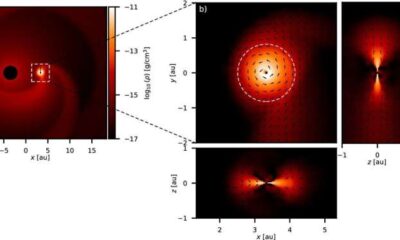Science
Scientists Reveal Dinosaur ‘Mummies’ Were Clay Molded Masks

In a groundbreaking study, researchers have determined that what was long thought to be preserved dinosaur skin in the Lance Formation of eastern Wyoming is actually a remarkably detailed clay mask. This finding sheds light on the preservation process of these prehistoric specimens, often referred to as “mummies.” The study, led by paleontologist Dr. Paul Sereno of the University of Chicago, highlights the unique conditions that contributed to the preservation of these fossils.
The Lance Formation, spanning less than 10 kilometers (6 miles), is noted for its rich deposits of dinosaur fossils. Among its most notable finds are several remarkably well-preserved specimens, including those of the duck-billed dinosaur, Edmontosaurus annectens. The region earned the nickname “the mummy zone” as paleontologists uncovered dinosaur remains that exhibited intricate details of skin, hooves, and spikes.
The historical context of these discoveries dates back to the early 1900s when fossil hunter Charles Sternberg unearthed two Edmontosaurus specimens, which were later analyzed by paleontologist H.F. Osborn at the American Museum of Natural History. The original skeletons displayed what appeared to be large patches of skin with visible scales and a fleshy crest along the neck. Dr. Sereno remarked on the significance of the initial finds, calling them “the greatest dinosaur mummy” until his team’s discoveries in 2000 and 2001.
Despite these revelations, a key question remained: how exactly were these specimens preserved? Dr. Sereno’s research aimed to clarify this mystery. Using advanced techniques such as CT scanning, 3D imaging, electron microscopy, and X-ray spectroscopy, the team analyzed the two mummies from the Lance Formation. What they discovered was unexpected — a thin layer of clay, less than one-hundredth of an inch thick, had formed over the skin of the dinosaurs.
Dr. Sereno noted, “It’s so real-looking, it’s unbelievable.” He proposed a new term, “rendering,” to describe the clay’s detailed impression of the dinosaurs’ skin, as opposed to the term “impression” used by earlier researchers.
The study outlines the environmental conditions that led to this unique preservation. During the Late Cretaceous Period, the climate in the area fluctuated between drought and monsoon rains. It is believed that droughts caused the deaths of the dinosaurs, leading to their rapid drying in the sun. Subsequently, a flash flood would have buried the carcasses in sediment. As the bodies decayed, a film of bacteria formed, attracting clay particles from the surrounding sediment. This process resulted in a clay mask that preserved the fine details of the dinosaurs’ exterior.
Dr. Anthony Martin, a professor of practice in environmental sciences at Emory University, commented on the findings, explaining how clay minerals can adhere to biological surfaces, creating detailed molds of skin and soft tissues.
Meanwhile, Dr. Stephanie Drumheller-Horton, a vertebrate paleontologist at the University of Tennessee, emphasized the need to understand fossilization processes. She believes that a deeper understanding of how these fossils form can enhance future discoveries, stating, “If we can understand how and why these fossils form, we can better target where to look to potentially find more of them.”
The recent discoveries allowed Dr. Sereno’s team to create an updated profile of the Edmontosaurus. Their analyses indicate that this dinosaur could grow to over 12 meters (40 feet) long, featuring a fleshy crest along its neck and back, as well as a row of spikes along its tail. The clay mask revealed the presence of hooves, a characteristic previously associated only with mammals, marking the Edmontosaurus as the oldest known land animal with hooves and the first documented hooved reptile.
Dr. Sereno humorously remarked, “Sorry, mammals, you didn’t invent it.” The insights gained from this research are significant, not only for paleontology but also for understanding the evolutionary history of dinosaurs.
The study was published in the journal Science on March 15, 2024, contributing valuable information to the field and paving the way for future explorations of dinosaur fossils.
-

 Science2 months ago
Science2 months agoOhio State Study Uncovers Brain Connectivity and Function Links
-

 Politics2 months ago
Politics2 months agoHamas Chief Stresses Disarmament Tied to Occupation’s End
-

 Science1 month ago
Science1 month agoUniversity of Hawaiʻi Joins $25.6M AI Project for Disaster Monitoring
-

 Science4 weeks ago
Science4 weeks agoALMA Discovers Companion Orbiting Giant Star π 1 Gruis
-

 Entertainment2 months ago
Entertainment2 months agoMegan Thee Stallion Exposes Alleged Online Attack by Bots
-

 Science2 months ago
Science2 months agoResearchers Challenge 200-Year-Old Physics Principle with Atomic Engines
-

 Entertainment2 months ago
Entertainment2 months agoPaloma Elsesser Shines at LA Event with Iconic Slicked-Back Bun
-

 World1 month ago
World1 month agoFDA Unveils Plan to Cut Drug Prices and Boost Biosimilars
-

 Business2 months ago
Business2 months agoMotley Fool Wealth Management Reduces Medtronic Holdings by 14.7%
-

 Science2 months ago
Science2 months agoInnovator Captures Light at 2 Billion Frames Per Second
-

 Top Stories2 months ago
Top Stories2 months agoFederal Agents Detain Driver in Addison; Protests Erupt Immediately
-

 Entertainment1 month ago
Entertainment1 month agoBeloved Artist and Community Leader Gloria Rosencrants Passes Away









